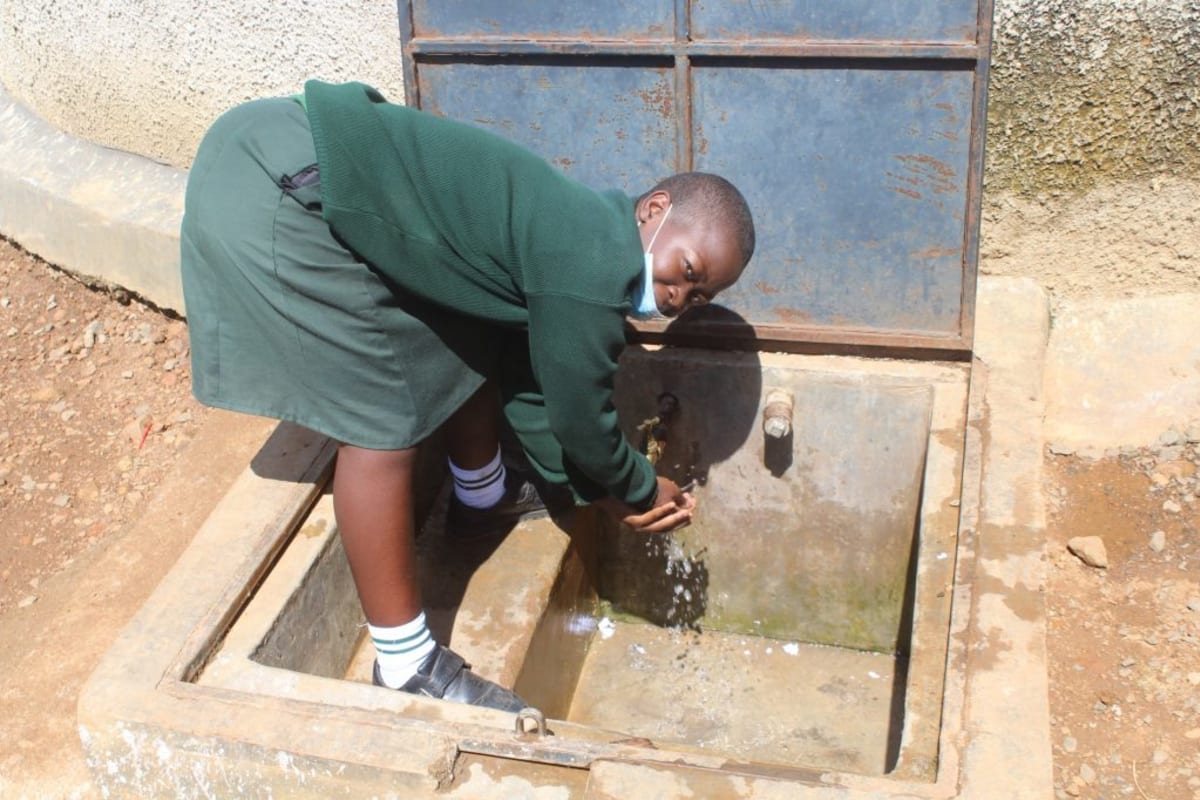January, 2021: Makunga Secondary School Project Complete!
We have exciting news!
Students and teachers finally arrived back in class at Makunga Secondary School following the Kenyan government's order to fully reopen all schools for in-person learning in January. As soon as students returned, their teachers invited our team to conduct our COVID-19 prevention, hygiene, and sanitation training.
While there, we also officially handed over the rain tank and latrines to the school. It was a joyous occasion, even with most smiles hidden behind masks. Students celebrated by drinking and splashing water, singing, dancing, and washing their hands.

Field Officer Protus Ekesa (right) hands over the rain tank to the school's principal
"The water will help me to avoid dehydration while in school since each time I feel like drinking water, I will be running to the tap and drinking, unlike in the past where I would carry water, and then it became hot," said pupil Sandra.
"I will improve in my studies. I have a dream of becoming a doctor, and with water around, I will now be able to dedicate my time to studies and excel in my exams," Sandra added.

Girls celebrate the rain tank
Teachers were just as excited as the students about the new rain tank on campus.
"When on duty, I will be having an effortless time in terms of time management from both the students and the meals being ready for the teachers. The students will be settling in class very fast without much time wastage. I will have enough time to revise with students, therefore achieving a higher mean score in my subjects, which are mathematics and chemistry," said teacher Madam Vivian Maiyo.

Principal and students pose at the rain tank.
Training
The school and our team agreed that adherence to physical distancing and mask-wearing whenever possible would be necessary to train the students safely. With a strict timetable to minimize exposure and an eager student body ready to learn, we sent facilitators Protus, Joyce, and David to lead the training.
11 students and teachers attended training, which we held inside a classroom and outside near the practical sessions' rain tanks. We focused on COVID-19 prevention, transmission, and symptoms while also covering several other topics.

Trainer Protus next to teacher Vibian Maiyo leading the handwashing exercise at training.
Other topics the facilitators covered included personal hygiene such as bathing, oral hygiene, the ten steps of handwashing; environmental hygiene; child rights; operation and maintenance of the rain tank, latrines, and handwashing stations; and leadership and governance.

Handwashing using a new station.
During the governance session, the students elected their peers to lead their newly formed student health club. The club will be greatly involved in the water, sanitation, and hygiene project management at their school. They will also be responsible for encouraging good health and hygiene practices amongst their peers, teachers, and the larger community.

Girls pose at their new VIP latrines.
We involved stretches, dances, and physical activities between each topic to keep the pupils’ energy up and their minds active. By the end of the training, each pupil understood their role in sustaining clean water and good health within their school community.

Handwashing at a new station.
The most memorable training topic was teaching the students the ten handwashing steps, our facilitators said. During this exercise, one student named Isaac said that they had washed hands "almost one million times" in only the two days since they had returned to school! We assured the students that while it can feel like a lot of handwashing, it is crucial to keep themselves healthy and safe from COVID-19 and all germs and diseases dirty hands can carry. Faridah, another student, said that the new ten-step handwashing technique was interesting and should be taken up by her peers immediately.

A student celebrates the rain tank.
This conversation led students to discuss all of the changes since their arrival at school and how they felt about them. Belton, whose peers elected him as President of their new student health club, lamented that he has to put his dream of becoming a great footballer on hold due to the suspension of organized sports in schools. He also joked that he had forgotten his friends' names since it had been such a long time since they last saw each other in March. But for the training, he was grateful.
"This training has opened my eyes to the simple things I have been doing wrong. I will now ensure that I improve on my personal hygiene and also keep my environment clean," Belton said.
The newly elected student treasurer of the club, Mary, also found value in training and shared what it has been like as a student home from school since last March.
"This information has changed my perspective on COVID-19. I will use this information to help my colleagues and me to take all the measures put down by the Ministry of Health to avoid contracting the disease, which is deadly," said Mary.

Girls at their new latrines
"The school closings affected my plan on completing school on time. My focus was also affected negatively because, at home, it was difficult to read with home chores. I am worried about the virus because it has affected our school calendar, and it has also claimed so many lives."
Mary said she missed her debate club at school the most while at home, but that she is now excited and grateful to be back since she was not even sure she would have the opportunity to continue her studies. And though school today looks different from what it did last year, Mary knows the changes are in the students' best interest and safety.
"The school is taking the temperatures of all the persons coming to school, we have handwashing stations at the entrance, and they are telling students to wear face masks and keep the social distance."

Trainer Joyce shows a student the correct way to put on and wear a mask.
After training, Mary said she will now add a few items to her personal prevention checklist.
"I will clean surfaces that I am using, I will be washing hands with clean and running water with soap for at least twenty seconds, and I will be wearing a face mask in the right manner," she said
When an issue arises concerning the water project, the students and teachers are equipped with the necessary skills to rectify most problems and ensure the water point works appropriately. However, if the issue is beyond their capabilities, they can contact our field officers' team to assist them.

Trainer Protus demonstrates use of the elbow for coughs and sneezes.
We will also continue to offer the school unmatchable support as a part of our ongoing monitoring and maintenance program. When schools fully reopen, we will continue to engage them in coronavirus prevention training and reminders.
Thank you for making all of this possible!

November, 2020: Construction Complete at Makunga Secondary School
Construction of the rain tank and VIP latrines at Makunga Secondary School is now complete!

The complete rain tank at Makunga Secondary School
When Kenya closed schools nationwide in March 2020 to help curb the spread of the novel coronavirus, we worked carefully to ensure already-planned projects like the one at Makunga Secondary School reached completion despite the closure. To achieve this, we relied on a combination of mutual trust and communication with the school and students' families to finish construction while keeping our team and the community safe.
Kenyan schools were initially scheduled to reopen in January 2021, when we planned to train students and teachers on COVID-19 prevention, handwashing, and how to take care of their new rain tanks and latrines.
However, recently, the Kenyan government allowed certain students to resume their classes for the remainder of 2020. Upon hearing this news, we treated the water in every school rain tank to ensure a fresh supply of drinking water for the returning pupils.

An Operation and Maintenance team stands on top of a school rain tank to measure the water levels through the removable cover to calculate the amount of treatment required.
With some students now back at Makunga Secondary School, we acted quickly to offer our health, hygiene, and COVID-19 training to better use the clean water from their rain tank to keep students and teachers safe and healthy. We are currently working with the school's administration to determine the best time for their training, as it depends on their students' immediate academic needs and their communities' risk level.

Clean water flows from the new rain tank
Until we can formally hand over the rain tank and VIP latrines to the school and conduct health and hygiene training, we consider this project “incomplete.” That is why we extended the expected completion date to the end of the year, though the final decision of when to host training rests with the school.
The training will ideally include students, teachers, and parents. This one-day intensive will focus on COVID-19 prevention and handwashing. The trainers will also cover a wide range of topics, including personal and environmental hygiene and the operation and maintenance of the rain tank, latrines, and handwashing stations.

A new VIP latrine block with three doors
Once we complete the health and hygiene training and safely celebrate the school's ownership of the project, we will be sure to send you an update.
Luckily, most students in this school live in communities where we have already completed several rounds of COVID-19 sensitization training. We are continuing to work with all of the communities we serve throughout the pandemic to keep their water running and help them stay informed of the latest COVID-19 guidance.
A New Page for Water & Sanitation at Makunga Secondary School
The rain tank has the ability to collect 75,000 liters of water, providing a new source of safe, clean water on campus. Combined with the six new VIP latrines we built and the installation of two new handwashing facilities, we look forward to seeing all of these components work together to unlock these students' opportunities to live better, healthier lives.
The latrines will be divided by gender, three for the girls and three for the boys. All of these new latrines have cement floors designed to be easy to use and clean, locking doors for safety and privacy, and vents designed to keep air flowing up and out through the roof. With a rain tank right on school property, there should be enough water to keep them clean.
How We Go From Ground to Rain Tank
Before schools closed, parents, staff, and students helped our artisans gather everything needed for construction. Even after the children went home, the school team of kitchen staff and a few parents helped provide meals for the artisans while the school provided accommodations. Local women and men helped our artisans with their manual labor, too.

Brick delivery at the school
The process officially began with our staff and school administration looking around the school compound to determine the best location for a new rain tank. This needed to be the best site with enough land and a nearby building with good, clean roofing to catch the rainwater.

Excavating the rain tank site
Then, we cleared the site by excavating the soil to make level ground for the tank foundation. We cast the foundation by laying big stones on the level ground and reinforcing them using steel wire, concrete, and waterproof cement. We affixed both the drawing pipe and the drainage pipe as we laid the foundation.

Pouring the tank's concrete foundation over a layer of stones
Next, we formed the walls using a skeleton of rebar and wire mesh with sugar sacks temporarily tied to the outside as backing. We attached this to the foundation’s edges so that the work team could start the Ferro-cementing process. They began layering the walls with cement, alternating with the inner and outer side, until six cement layers were in place. (The sugar sacks are removed once the interior receives its first two layers of cement.)

Wire tank walls covered in sugar sacks for temporary support
Inside the tank, we cast one central and four support pillars to ensure the dome does not cave in once cemented. Meanwhile, we plastered the inner wall while roughcasting the outer walls. We dug and plastered the access area to the tap outside of the tank, where we also installed a short staircase. In front of the access area, we constructed a soak pit where spilled water can drain from the access area through the ground. The pit helps to keep the tap area dry and tidy.

Casting the central support pillar
Dome construction could begin after the tank walls settled. We attached a dome skeleton of rebar, wire mesh, and sugar sacks to the tank walls before cementing and plastering it using similar techniques as the wall construction. We included a small manhole cover into the dome to allow access for future cleanings and water treatments.

Plastering the pillars
We propper long wooden poles (about 75 of them!) inside the tank to support the dome while it cured. Then it was down to the finishing touches: fitting a lockable manhole cover over the tap area, affixing the gutters to the roof and tank, and setting an overflow pipe in place at the edge of the dome for when the tank reaches capacity.

Cutting the dome's wire form to size
Once finished, we gave the rain tank three to four weeks to undergo complete curing. Finally, we removed the interior support poles and dome sugar sacks and cleaned the tank.

Using water form the tank for curing
Thank you for helping to make this work possible - stay tuned for an update on training and the handing-over celebration!




 Rehabilitation Project
Rehabilitation Project
















































